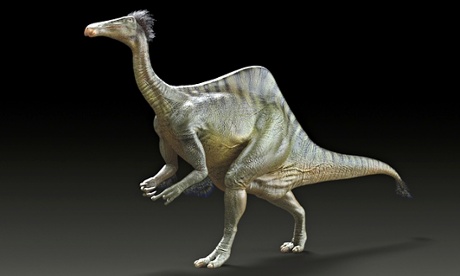Deinocheirus mirificus, or ‘unusual horrible hand’, had long, clawed forearms, a sail on its back and a duck-like bill
Nearly 50 years after researchers uncovered the gigantic arms of a
mysterious dinosaur in the Gobi desert, the true nature of the beast has
finally been established.
Since its discovery in 1965, the only clues to the engimatic creature
were its shoulders and forelimbs – the latter measuring an astounding
2.4 metres long – and a few ribs and vertebrae dug from the ground by a
joint Polish-Mongolian expedition.
The fossils were extraordinary enough for scientists to declare the
dinosaur a new genus and species. The name they decided upon was Deinocheirus mirificus, meaning “unusual horrible hand”.
In the absence of more complete remains, early reconstructions were
at times wildly speculative. In 1970, one palaeontologist argued that
Deinocheirus was a giant sloth-like climber
that hung beneath the branches of enormous trees. A more accurate view
put the dinosaur in a group of beaked omnivores called ornithomimosaurs,
which resembled giant ostriches, at least superficially.
But writing in the journal Nature
on Wednesday , a Korean-led team of experts has transformed scientists’
understanding of the animal. They report the discovery of two nearly
complete 70 million-year-old Deinocheirus skeletons, pieced together
from fossils unearthed in Mongolia, along with a skull and hand that had
been poached and sold on to private collectors.
With the new remains, the researchers built the first accurate
reconstruction of the dinosaur. The creature stood tall on its back
legs, but sported long, clawed forearms. Neural spines formed an
impressive sail on its back and its long, toothless snout flared out to
both sides. The duck-like bill may have helped Deinocheirus forage for
food at the bottom of streams, while blunt, flattened bones under its
claws prevented it from sinking on wet ground.
One of the new specimens grew to 11 metres long and weighed more than
six tonnes. Its broad hips and large feet suggest it was not agile. The
animal likely fed on plants and small animals, though the remains of
fish were found among its stomach contents.
Read more here

No comments:
Post a Comment